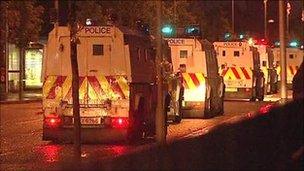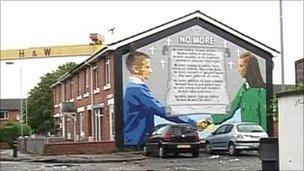East Belfast interface: a familiar pattern continues
- Published

The violence in the Short Strand on Monday was the worst in the area for almost ten years
Violence at the Lower Newtownards Road interface is a recurring theme in the history of sectarian trouble in Northern Ireland.
On the cusp of east Belfast, the nationalist enclave of Short Strand sits beside estates and streets populated almost exclusively by loyalists.
The only thing separating the two communities are several "peace walls" - high artificial barriers which physically separate Catholic and Protestant homes.
Across Belfast, there are now more such walls than there were when republican and loyalist paramilitaries first went on ceasefire in 1994.
Strife
In some areas, including the Newtownards Road interface, political progress has not meant an end to sectarian strife.
In 2002, four years after the Good Friday Agreement, east Belfast saw some of the worst street violence in a generation.
Attacks with missiles, improvised bombs and even firearms became a daily feature of life for eight months.
Police officers and civilians were regularly injured while some residents chose to move to other parts of Belfast rather than continue to live in an area blighted by violence.
Tension
For those with knowledge of the area's past, it was a familiar pattern.
Catholics first moved into the Short Strand from east and south Down in the late 19th century, building their own schools and their own church, St Matthew's.
Historian Eamon Phoenix says that despite living next to the shipyard, Catholics were largely excluded from finding work there.
"The tension really became prominent in 1920 to 1922 when 500 people died in what was basically a sectarian civil war," he said.
Eleven more people died in further violence in the area in 1935 but it is an incident at the beginning of the Troubles in 1970 that remains prominent in the minds of people still living in the area.
During a long night of violence, loyalists attacking St Matthew's Church were repelled by republican gunmen within the grounds. Five people died.
"It is seen as a moment of great significance - the first real emergence of the Provisional IRA," Dr Phoenix added.
Since the renewed trouble in 2002, community workers on both sides of the wall have been meeting formally and regularly in an effort to reduce tensions.
Sporadic
Neil Jarman from the Institute for Conflict Research at the University of Ulster has been following their work since carrying out a study in the area six years ago.
He says that attempting to establish how the trouble starts after a previous lull is extremely difficult.
"If you talk to one side you will get one story and if you talk to the other, they will tell you something entirely different," he said.

Significant efforts have been made to bring Catholics and Protestants in the area closer together
"What we do know is that often there are sporadic bits of trouble which are so relatively small that they often go unreported by the media.
"But they are the source of significant tension in the area and can lead to something much worse like we've seen in the last 24 hours."
He added that it was too simplistic to see the trouble purely in terms of two communities unable to live alongside each other.
"The police have spoken about the role of the UVF in this violence and I think a proper analysis of what has happened needs to take into account paramilitaries and how they might be asserting a role for themselves."
In the meantime, politicians, community workers, and the police will continue to try to reduce the gap between the unhappy neighbours.
After more than 100 years, it is still a work in progress.
- Published21 June 2011
- Published9 March 2011
- Published28 July 2010